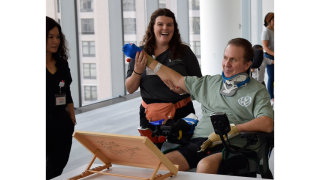Body
The Americans with Disability Act (ADA) and the Air Carrier Access Act (ACAA) have helped make transportation services for people with disabilities accessible. This includes airports and aircraft carriers.
Know Your Rights!
- Check with Airline and/or Airport website for full accessibility information.
- US Department of Transportation: https://www.transportation.gov/airconsumer/passengers-disabilities
- https://www.transportation.gov/individuals/aviation-consumer-protection/traveling-disability
- Complaint Resolution Officer (CRO) assist travelers with disabilities in resolving difficulties
- Service animals: https://www.transportation.gov/individuals/aviation-consumer-protection/service-animals
Planning ahead and using the guidelines below can help ensure a successful journey. Start with identifying your needs when planning to travel by air and be prepared to ask plenty of questions.
Booking Travel
- Plan in advance, most airlines have a customer service department that is familiar with special service requests.
- Identify your travel date, destination
- Identify your Disability
- Physical – mobility
- Sensory – hearing, vision
- Cognitive / Communication
- Hidden – allergies, sensitivities
- Be specific about all travel needs including assistance to and from gate/baggage area. Share if you are traveling with a service animal using oxygen or any medical concerns.
- Confirm reservations and requests at least 48 hours prior to departure.
- First time travelers with a disability may prefer to use a travel agent that specializes in disability travel. Many companies now offer information and travel plans for people with disabilities. Talk with friends or colleagues about their travel experiences also.
- Ask about refund policies in case of unforeseen problems that could affect travel.
- Ask about reduced fares for a companion or caregiver if appropriate.
- Ask about insurance for lost or damaged wheelchairs or mobility aids.
- Arrange for additional coverage if necessary.
Note: Special Service Request (SSR) codes are entered into the airline computer system at the time you make a reservation. Speak with an airline representative to convey specific needs. Do not make reservations online.
Mobility
- If you use a wheelchair or other mobility aid (cane, walker, etc) provide this information to the airline agent when making the reservation including battery type for power chair or scooter users.
- Know the dimension of any equipment or device. Discuss with the agent how you will get on the plane and where equipment will be stored.
- Consider distance to be traveled within the airport. Ask for a wheelchair to use from curbside to the gate. Airport escort and transport services are also available.
- Call the airport to learn about parking, transportation, and accessible entrances.
Sitting Tolerance
- Air travel typically requires long sitting times, both while at the airport and while on the plane. Usually, passengers with disabilities board first and get off last.
- Ask for a bulkhead seat to provide more legroom if this is helpful. An emergency exit row has more legroom and people who can help in the event of an actual emergency are seated in these locations.
- For people who use a wheelchair and typically perform pressure reliefs it will be important to plan ahead. Alternative seating options may be the answer. Removable arm rests or bulkhead seats can provide more room to apply reliefs. It may also help to use the cushion from the wheelchair on top of the airplane seat (it may need to be deflated a bit because of cabin air pressure.)
Toileting
- Some travelers may choose to limit food and drink intake before and during the flight since it is difficult to use the restroom while on the plane.
- Plan in advance how a trip to the restroom will be accomplished if necessary.
- Ask for an aisle chair or find out whether the aircraft has accessible lavatories. Aircrafts with more than one aisle and several lavatories must have at least one that is accessible.
- Bring needed equipment, such as a blanket for coverage during catheterization, or an empty plastic bottle to collect the urine. These items can easily be slipped into a bag or box when exiting the plane.
- A flight with stopovers can be another option. This allows the use of bathroom facilities in the airport with less hassle.
Medical Concerns
- Remember to travel with all medications. Most people prefer to carry medicine on the plane in case luggage is lost.
- Bring a list of medications, physician contact information, emergency contact numbers, and health insurance information.
- Be aware of the effects of alcohol while flying. It can make manipulating a wheelchair or mobility aid more difficult.
Day of Travel-Getting on the Plane
- When booking the flight find out how much time to allow for checking in based on your needs.
- Check airport website for accessibility features for parking, drop-off and transportation.
- People with disabilities are subject to the same security checks as other passengers; however, airport metal detectors are ineffective with wheelchairs and other mobility aids. You will be required to go through a hand check procedure. You have the right to request a private screening. Be sure to follow the rules and be aware of your rights.
- Wheelchairs are checked in at the gate. You are entitled to stay in the chair until boarding the plane. There may be room for one manual wheelchair to be stored in the coat closet on the aircraft; most often, wheelchairs are stowed in the baggage compartment. Ask where your equipment will be stored during the flight.
- It is helpful to know the chair dimensions while traveling to ensure that it will fit into the storage area.
- Make sure that your name and address are on all pieces of equipment. To help prevent damage, remove seat cushions or any other loose items.
- According to the Air Carrier Access Act, airlines must store electric wheelchairs upright so that batteries do not need to be removed from the chair. Just in case, consider attaching directions with a picture for removing the batteries, assembling, and operating the chair.
- You may be initially seated in a special aisle chair just before getting on the airplane and then transferred to your seat. Reconfirm with the customer service agent at the boarding gate during check in that you require an aisle chair to board the plane, and any other assistance you may need with your transfer (ie. two person transfers). Most airlines have trained staff but feel free to direct your care (lifting or positioning, etc) if necessary.
- While on the flight, remind a flight attendant that you want gate delivery of the wheelchair or scooter.
Day of Travel-Getting off the Plane to the Baggage Area
- Last to leave plane.
- Remind flight attendant of your service requests, i.e., transfer assistance to aisle chair for getting off plane, retrieval of stowed wheelchair, walking device or oxygen tank, escort to baggage.
- Airport transfer team will assist you in getting off the plane and retrieving stowed items.
- Escort service to accompany to baggage.
- Notify CRO for any problems or inconveniences via DOT hotline for airline travelers.
- DOT hotline - M-F 9am-5pm
- 888.368.7238 Voice
Personal Considerations
Pace yourself - Plan for Breaks – Be mindful of your travel distance and endurance
- To the airport
- Incorporate travel time to the airport.
- Know the location of loading / parking zones.
- Within the airport
- Plan for restroom breaks (family restrooms).
- Plan for snack / beverage break.
- Plan for animal assistance break.
- Identify medical support areas via airport information booths.
- Ask about alternative formats, i.e., sign language interpreters, audio / visual paging.
- Be Mindful of your full travel time
- Sitting tolerance.
- Endurance.
- On the plane
- Incorporate changing positions, stretching.
- Plan for use of the restroom or a method to relieve yourself.
- From the airport to your destination
- Anticipate distance to baggage claim.
- Plan for restroom break after leaving the plane.
- Prearrange ground transportation.
These are just a few things to consider when planning air travel. Provided that you are resourceful, assertive, and plan ahead there is no reason why your trip should not be a success. It may be helpful to get a copy of the Air Carrier Access Act for your own personal reference as to what the laws are for traveling with a disability. Should you encounter a problem, while traveling, every airline is required to have a complaint resolution officer (CRO) on staff during scheduled flight times to report any situations you may encounter.
The U.S. Department of Transportation (DOT) has established a toll-free hotline to assist travelers with disabilities: 800.778.4838 (voice); 800.455.9880 (TTY); 1200 New Jersey Ave., SE, Washington DC, 20590; http://airconsumer.ost.dot.gov.
Body
This content is for informational purposes only and may not be comprehensive. Information contained does not imply an endorsement from Shirley Ryan AbilityLab, and does not replace the advice of a qualified healthcare professional. See here for further details. © Shirley Ryan AbilityLab (formerly Rehabilitation Institute of Chicago). Henry B. Betts LIFE Center – (312) 238-5433 – https://www.sralab.org/lifecenter.



